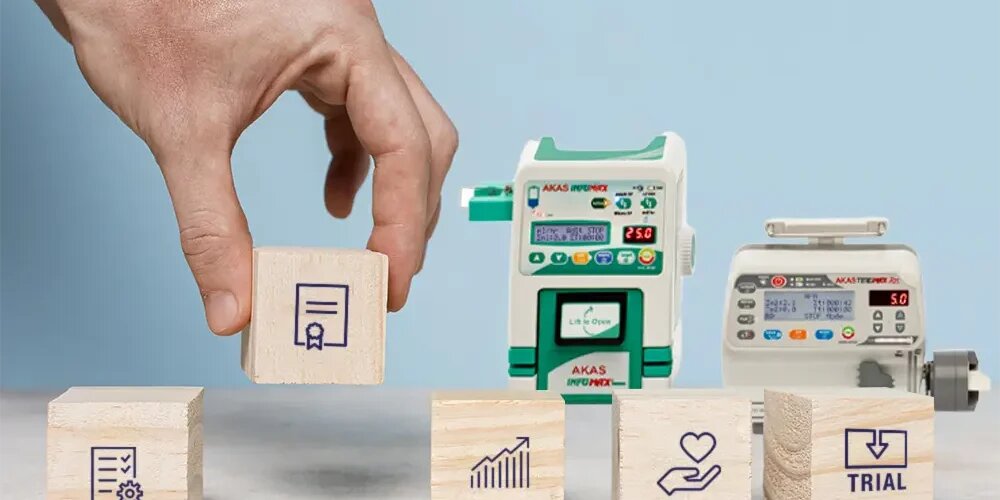Delivering medication accurately, safely, and consistently is vital in any hospital setting. The infusion pump plays a pivotal role in achieving this, especially in intensive care units, emergency departments, neonatal wards, and operating theatres. Choosing the right device can significantly improve patient outcomes, reduce workload for healthcare staff, and align with safety protocols.
Modern hospitals must evaluate an infusion pump's basic function, technology, design, and compliance features. Below are the top considerations every hospital should keep in mind when procuring this critical equipment.
1. Precision in Flow Rate Control
– Accuracy in flow rate is crucial for safe drug administration.
– A modern infusion pump should deliver precise volumes, even at low flow rates.
– This helps prevent over-infusion or under-infusion, especially in paediatrics and critical care.
2. Smart Drug Library Integration
– Built-in drug libraries reduce medication errors at the bedside.
– Pumps with programmable dosing limits alert staff before unsafe entries.
– Seamless updates ensure that all clinical protocols remain current.
3. User-Friendly Interface and Display
– An intuitive touch-screen or control panel enhances workflow.
– Clear visual indicators minimise training time and errors during emergencies.
– Hospitals benefit when devices are easy for all clinical staff to navigate.
4. Multiple Therapy Modes
– Flexibility in infusion types such as continuous, intermittent, and PCA (Patient-Controlled Analgesia).
– Pumps should support various therapies without requiring separate machines.
– This ensures space-saving and cost-effectiveness across departments.
5. Alarm and Alert Systems
– Advanced alarm features ensure timely notifications for occlusions or air-in-line.
– Customisable volume and tone help reduce alarm fatigue in high-pressure units.
– Alerts must be distinguishable and intelligently prioritised.
6. Wireless Connectivity and EMR Integration
– Integration with hospital Electronic Medical Records (EMR) improves accuracy.
– Automatic documentation reduces manual entry and clinician workload.
– Wireless communication supports real-time monitoring and updates.
7. Battery Life and Portability
– Long-lasting battery support is essential for intra-hospital patient transport.
– Devices should remain reliable even during power outages or emergencies.
– Portable designs allow versatile use across multiple care areas.
8. Durability and Build Quality
– A modern infusion pump must withstand daily clinical wear and disinfection cycles.
– Shock resistance and waterproof designs add to long-term reliability.
– Hospitals need equipment that performs consistently in demanding environments.
9. Safety Mechanisms and Auto-Lock Features
– Auto-lock functions prevent accidental changes to infusion parameters.
– Anti-free-flow systems are vital to prevent unregulated medication delivery.
– Safety-first design helps uphold hospital patient care standards.
10. Customisable Settings Based on Patient Profiles
– Pumps should allow configuration for neonates, adults, or geriatrics.
– Adjusting flow precision according to patient type ensures clinical accuracy.
– This feature supports personalised treatment plans and optimised dosing.
11. Easy Maintenance and Cleaning Protocols
– Smooth exteriors and minimal crevices aid in infection control.
– Easy disassembly and reassembly support faster maintenance cycles.
– Hospitals benefit from minimal downtime and reduced servicing costs.
12. Service Support and Training Availability
– Continuous staff education ensures safe and effective use.
– Manufacturers should offer on-site and virtual training resources.
– Good service support reduces the risks of equipment-related incidents.
13. Compliance with Global Standards
– Compliance with ISO, CE, and FDA standards reflects quality and safety.
– Hospitals should ensure that devices meet local regulatory requirements.
– Certified devices build trust and streamline approval for clinical use.
14. Scalability Across Departments
– Uniformity across ICU, OR, and general wards improves standardisation.
– Pumps that adapt to various clinical needs ensure operational efficiency.
– Hospitals benefit from simplified training, maintenance, and inventory control.
15. Clear Infusion History and Data Logs
– Data storage and logs aid in clinical auditing and incident tracking.
– Advanced models allow retrieval of complete infusion history.
– Reliable logs support transparency and accountability in treatment.
16. Noise Level and Patient Comfort
– Low-noise operation is essential for neonatal and palliative care wards.
– Patients rest better when devices are silent and non-intrusive.
– Comfort-focused features support holistic patient-centred care.
17. Modular Compatibility for Future Upgrades
– Devices should allow upgrades without full replacement.
– Modular designs are cost-efficient and support evolving hospital needs.
– Scalable models support long-term infrastructure planning.
18. Visual Clarity for Night-Time Use
– Backlit displays and night modes improve visibility in darkened rooms.
– This is particularly helpful in NICU and postoperative recovery areas.
– Staff efficiency improves with displays that are readable at all hours.
19. Automated Bolus Options and Ramp-Up Settings
– Programmable bolus delivery enhances patient response during critical dosing.
– Gradual ramp-up or taper settings support sensitive treatments.
– These features aid in adapting infusion to clinical requirements in real time.
20. Environmental and Energy Efficiency
– Energy-efficient designs reduce hospital operational costs.
– Environmentally responsible manufacturing supports green initiatives.
– Hospitals increasingly value devices that align with sustainability goals.
Conclusion
Every hospital requires a trusted and high-performing infusion pump that balances technology, safety, and ease of use. These critical devices play a central role in modern treatment workflows, affecting both care outcomes and operational efficiency.
Hospitals seeking dependable partners for long-term drug delivery solutions should turn to manufacturers that demonstrate excellence in engineering, safety, and service. Akas Infusion stands as a name committed to quality, producing world-class drug delivery devices such as volumetric pumps designed for the most demanding medical environments.





Comments